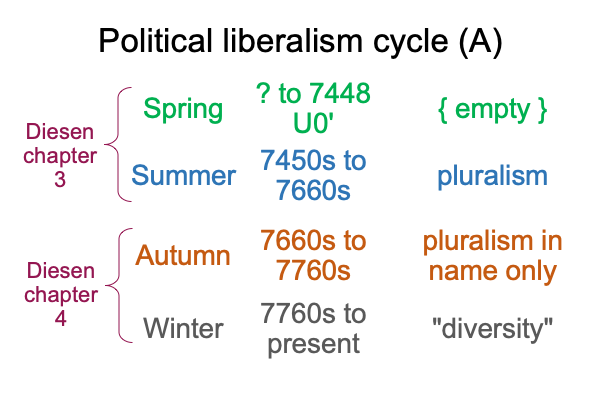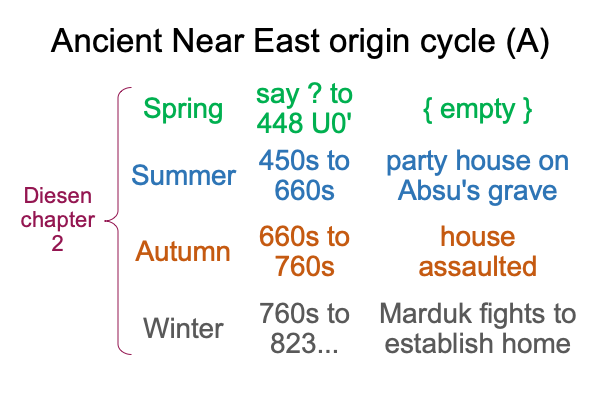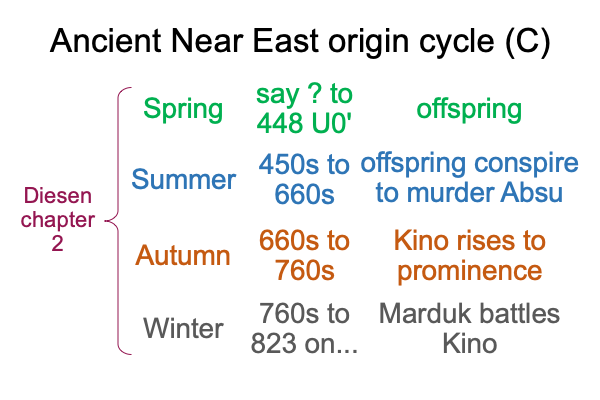0166 Does Diesen’s Greimas square work allow the inquirer to imagine civilisational cycles preceding the most recent cycle?
What civilisations are around before the civilisational cycle of political pluralism?
Here is a picture of the current cycle.

Note how the time scale has changed from Anno Domini to Ubaid Zero Prime.
0 U0′ roughly corresponds to the consolidation of the Ubaid culture in southern Mesopotamia.
7823 years ago, the Ubaid is the only culture practicing speech-alone talk and all surrounding Neolithic cultures rely on hand-speech talk (the way of talking since the first anatomically modern humans).
According to Razie Mah’s masterwork, An Archaeology of the Fall, the adoption of speech-alone talk potentiates unconstrained social complexity.
What does that imply?
Civilisational cycles commence with the first singularity.
0167 If the recent cycle in Western civilisation is any indication of timing, cycles tend to complete every 400 or 500 years.
Weirdly, such timing corresponds to the progressions of Saturn-Jupiter conjunctions through any three consecutive zodiac signs. Saturn-Jupiter conjunctions occur roughly every 20 years. Saturn-Jupiter conjunctions in any given sign occur every 60 years, with each conjunction advancing around 13 degrees. So, a conjunction at, say 0 degrees Aquarius, in 2020, will occur in Aquarius again in 2080, at 13 degrees, then in 2140, at around 26 degrees, then in Pisces around 10 degrees in 2200, then at 23 degrees Pisces in 2260, then in 6 degrees Aries in 2320, 19 degrees Aries in 2380 and around 1 degree Taurus in 2440.
Say what?
Saturn-Jupiter conjunctions start in Aquarius in 2020 and leave Aries, three signs later, around 2440. That is 420 years.
Well, the idea is weird for moderns, but for the ancients, the celestial sphere works like a clock. I may call that clock, “the celestial Earth”. I may also call it, “the celestial half of Tiamat”.
0168 With this in mind, consider Diesen’s recollection of a written origin story of the ancient Near East (located in chapter 2, see points 0041-0060).
As a thought experiment, let me propose that this story covers the second civilizational cycle of an archaeological period in Mesopotamia, occupying a time frame similar to Western civilisation’s seasons of sovereignty, but shifted back 7400 years.
0169 Here is a list of seasons for A, the civilisational manifestation.

0170 Why the second cycle?
0171 Absu (B), the father and order, is already separated, as gesellschaft, from Tiamat (D), the mother and chaos, who is the theme of the cycle. To me, this implies that the story tells of a second cycle, occurring in a hand-speech talking culture outside of the Ubaid, after it adopts speech-alone talk in imitation of the Ubaids.
0172 The Ubaid forms on the edges of the newly-filled Persian Gulf. The Ubaid practices a speech-alone talking creole. They speak (what we will later call) the Sumerian language, which is not related to any family of languages. Adjacent hand-speech talking cultures are influenced by the increasing wealth (labor specialization) and power (social specialization) of their speech-alone talking neighbor.
0173 In order to imitate the Ubaid culture, neighboring Neolithic folk drop the hand-talk component of their hand-speech talk. The timeless shamans resist. Yet, certain factions insist on not using their hands anymore while talking. These factions are able to identify, in speech, certain terms that cannot be performed in hand talk. They identify Absu, the father, who compares favorably with the increasingly underperforming shamans. Well, the shamans underperform only when compared to the Ubaid, who trade mats, woven from reeds, for permission to chop down the trees in the area.
By the end of the first cycle, the culture living in the shadow of the Ubaid differentiates Absu (B) as gesellschaft and Tiamat (D), not as gemeinschaft, but as the theme, chaos. What happened? Well, the timeless shamans, who try to warn the folk and impede the adoption of speech-alone talk, are gone. Everyone now practices speech-alone talk, in the family of (what we now call) the Semitic languages.
0174 In the spring of the second cycle, the manifestation of chaos (A) makes no impression. Absu (the gesellschaft that destroyed the shamans, B) and Tiamat (the chaos once represented by the shamans, D) produce offspring (specialized groups within the folk, gemeinschaft (C) arising from gesellschaft (B)). All this is made possible by the semiotics of speech-alone talk.
0175 In the summer of the second cycle, the offspring (various gemeinschafts (C) that increasingly fail to recognize Absu (B) as legitimate) murder Absu (B) and build a party-house on his grave (A). I call it a “party house” because every chamber of the house has its own special attractions, its own special way of gossiping about everyone else, and its own exclusivity. The chaos (D), attributed to the deceased shamans, slumbers as the different echo-chambers (C) talk about how they are going to do this or that (B). All the gemeinschafts (C) conspire to promote their own gesellschafts (B) above the one who can never return to life, the murdered Absu.
0176 In the autumn of the second cycle, the echo-chambers (B and C) are increasingly at odds with one another. The squabbling and politicking stirs Tiamat from her slumber (D). Politics with hand-speech talk was never as loud or as noisy as the jabbering and the posturing in speech-alone talk. The folk are disordered, disunited and dismayed.
From within the gemeinschaft (C), a movement is afoot, saying, “Let us return to the ways of the timeless shamans.” But, there is a problem. There is no way to return to the ways before speech-alone talk because all the timeless shamans are dead. They have been dead for many conjunctions of the slowest of the wandering stars. How can we, the gemeinschaft, call them back from the…
Oh! What about Kino? Kino can channel the chaos of Tiamat. Kino can create a new world powered by the newly awakened Tiamat!
Who will respond to that monster, Kino, the one that all the echo-chambers are worried about?
All the little gods of the already shaken party palace search for a hero, a gesellschaft, capable of re-establishing their prerogatives.
0177 In the winter of the second cycle, a hero for diverse gesellschaft steps forward and does battle with Kino. In the year of 823 U0′, no one knows who will win.
0178 Today, while reading a handful of cuneiform tablets recovered from the ruins of an ancient library, we know.
Marduk wins. Marduk establishes the pantheon, the gesellschaft (B) that conquers chaos (D).
Plus, Kino’s defeat is significant to us. From the blood of the ruined Kino (C), Marduk (B) makes humans. Marduk fashions us from the blood of a gemeinschaft trying to return to the original justice of the timeless shamans.
Plus, Tiamat’s final fate is significant to all creation. From the corpse of the conquered Tiamat (D), Marduk fashions the sky-bearing face of the celestial Earth and the earth-bearing face of the mundane Earth. The heavens and the earth, the celestial Earth and mundane Earth, look upon one another through the realm in which Marduk rules. Marduk rules between heaven and earth.
0179 Here are the four seasons of the imagined second cycle, for a semitic-language-speaking culture neighboring the Ubaid, which is absorbed into the Uruk, before the Sumerian Dynastic.
The story that Diesen recounts remembers what cannot be remembered, that is, the tempestuous story of how we came to be.
Here is a list for gemeinschaft (C).

